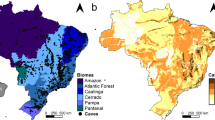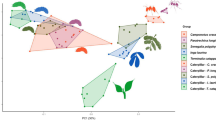Summary
The Weaver Ant,Polyrhachis simplex, which in India belongs to a tropical fauna, occurs in Israel in a circumscribed desert region which comprises the western limit of its spread. The biology ofP. simplex features a number of highly interesting phenomena:
-
1.
Weaving occupies a central position in the life of the colony. The workers construct the nests with the aid of silk secreted by the larvae. The silk glands of the larva are consequently highly developed.
-
2.
Aphids of several species are visited by the weaver ant for their honeydew, which constitutes a primary food source for the ant.
-
3.
Seasonal vertical migration of the ants occurs twice a year-in the winter and in the late spring.
-
4.
«Cemeteries» are marked off by the ants at considerable distances from the nests, for the purpose of disposing of their dead. A single «cemetery» may sarve several widely-separated ant colonies.
The present investigation is the first in which colonies ofP. simplex have been successfully reared in the laboratory, using a special sugar solution as a substitute for the natural food of the ants. The laboratory-reared colonies developed normally, maintained the usual daily activities (including weaving) and reproduced through several generations.
Résumé
La fourmi fileuse,Polyrhachis simplex, qui appartient en Inde à une faune tropicale, se rencontre en Israël dans une région désertique correspondant à la limite occidentale de son extension.
La biologie de cette espèce présente un certain nombre de caractères intéressants:
-
1
Le filage tient une place de premier ordre dans la vie de la colonie. Les ouvrières construisent les nids à l'aide de la soie sécrétée par les larves et en conséquence les glandes séricigènes de ces dernières sont très développées.
-
2
Des Aphidiens de plusieurs espèces sont visitées par les ouvrières qui trouvent dans le miellat une source importante de nourriture.
-
3
Une migration saisonnière verticale a lieu deux fois par an, en hiver et à la fin du printemps.
-
4
Des «cimetières» sont constitués par les fourmis à des distances considérables des nids afin d'y déposer les cadavres. Un seul «cimetière» peut être utilisé par plusieurs colonies bien séparées.
Au cours de cette étude, il a été possible, pour la première fois, d'élever des colonies de cette espèce au laboratoire en utilisant une solution de sucre particulière au lieu de la nourriture naturelle. Les colonies élevées au laboratoire se développaient normalement, maintenaient leur activité journalière (y compris le filage) et se sont reproduites durant plusieurs générations.
Similar content being viewed by others
Literature
Avidov (Z.), 1961, with contributions by Dr.Harpaz (I.) and Dr.Swiersky (E.). —Pests of the cultivated Plants of Israel (in Hebrew), p. 546. Magnes Press «The Hebrew University», Jerusalem.
Bingham (C. T.), 1903. —Fauna of British India, including Ceylon and Burma. Hymenoptera, vol.II. Taylor and Francis, London.
Bodenheimr (F. S.) andTheodor (Osk.), 1929. —Ergebnisse des Sinai Expedition Der Hebraishen. Universitat Jerusalem, 1927. Leipzig, p. 45–88.
Bytinski-Salz (H.), 1953. — The Zoogeography of the ants of the Near East.Revue de la Faculté des Sciences de l'Université d'Istanbul, série B,XVIII fasc. 1.
Collingwood (C. A.), 1960. —Formicidae (Insecta) from Afganistan. Reprinted from Vidensk. Medd. Fra Dansk Naturh Foren, bd. 123.
Emery (C.), 1925. —Formicidae (vol. III), p. 196.
Finzi (B.), 1936. — Risultati Scientifici della Spedizione di S.A.S. il Principe Alessandro Della Torre e Tasso nel «Egitto E Penisola del Sinai» XI «Formiche».Bulletin de la Société Royale Entomologique d'Egypte, p. 155–210.
Forel (A.), 1910. — Glanures myrmécologiques. «Fourmis de Palestine et Syrie».Ann. Soc. Ent. Belg., vol.54, p. 14.
Forel (A.), 1923. —The Social World of the ants, vol. I–II. London and New York. G. P. Putman's Sons, Ltd., 1928.
Hingston (R. W. G.), 1923. —A Naturalist in Hindustan.London, H. F. and G. Witherby, p. 98–103.
Ikan (R.), andIshay (J.), 1966. — Larval Wasps Secretions and Honeydew of the Aphids, Chaitophorus Populi, Feeding on Populus Eufharitica as Sources of Sugars in the Diet of the Oriental Hornet, Vespa Orientalis, F.Israel Journal of Zoology,15, p. 64–68.
Jodlowski (J.), 1930. —Ueber die Histologischen Bau der Spinndrusen bei Ameisenlarven. Présenté dans la séance du 1er décembre 1930, parM. H. Hoyer.
Karawajew (W.), 1929. — Die Spinndrusen der Weberameisen (Hym. Formicidae).Zool. Anz.,82, p. 247–256.
Lefroy (H. M.) andHowlett (F. M.), 1909. —Indian Insect Life. Agric. Res. Inst. (Pusa) Thacker, Spink and Co., p. 232.
Menozzi (C.), 1933. —Le Formiche Della Palestina. Retratto dalle Memorie Della Societa Entomologica Ital., vol. XII.
Michael (A. D.), 1901. —British Tyroglyphildae, vol. I, p. 162–164. Ray Society, London.
Mor (I.), 1957 (in Hebrew). —Researches on the ecology of olive fly-Dacus oleae.
Schröder (W. A.) andKay (L. M.), 1955. —J. Ann. Chem. Soc.,77, p. 3908.
Skaife (S. H.), 1961. —The study of ants Longmans.
Stein (W. H.) andMoore (S.), 1958. —Anal. Chem.,30, p.1190.
Wasmann (E.), 1905. — Beobachtungen über Polyrachis dives auf Jave, die ihre Larven zum Spinnen der Nester Benutzt.Notes of the Leyden Mus.,25, p. 133–140.
Wheeler (G. C.) andWheeler (J.), 1953. — The Ant Larvae of the subfamily Formicinae. Reprinted fromAnnals of the Entomological Society of America, p. 126–171, 175–217.
Wheeler (W. M.), 1910. — Ants their Structure,Development and Behavior. Columbia University Press, N. Y. Third. Printing, 1960.
Wheeler (W. M.), 1915. — On the Presence and Absence of Coccoons among Ants, the Nest Spinning Habits of the Larvae and the Significance of the Black Coccoons, among certain Australian species.Ann. Ent. Soc. America,8, p. 323–342.
Wheeler (W. M.), 1928. —The Social Insects. Their Origin and Evolution. Harcourt, Brace and Co., N. Y.
Zohary (M.), 1955 (in Hebrew). —Geobotany.
Zohary (M.), 1957 (in Hebrew). —Plant World.
Author information
Authors and Affiliations
Additional information
This study was supported by a grant from the Committee for the Encouragement of Research and Post-Graduate Studies, General Federation of Jewish Labour in Israel.
Rights and permissions
About this article
Cite this article
Ofer, J. Polyrhachis simplex The Weaver Ant of Israel. Ins. Soc 17, 49–81 (1970). https://doi.org/10.1007/BF02223772
Issue Date:
DOI: https://doi.org/10.1007/BF02223772




